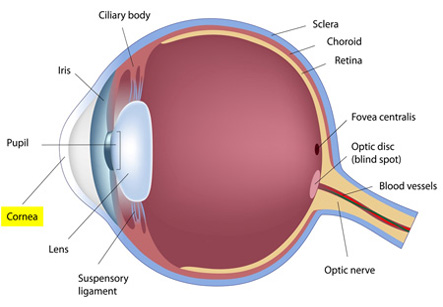Corneal Diseases
Introduction
The cornea is the transparent watch glass like tissue that covers the front of the eye. The cornea is smooth and clear as glass but is as strong and durable as plastic. These properties help the eyes in two ways:
• The cornea provides a natural physical barrier that shields the eye from germs, dust, and other harmful material. It shares this protective function with the sclera (the white of the eye).
• It acts as the outermost lens of the eye. When light strikes the cornea, it bends–or refracts–this incoming light onto the crystalline lens. The lens then focuses the light on the retina, the paper-thin tissue at the back of the eye that converts the light into vision.
The cornea usually copes very well with minor injuries or abrasions. If dirt scratches the highly sensitive cornea, the epithelial cells of cornea slide over quickly and cover the injury before infection occurs and vision is affected.
But in case of a deep scratch, the healing process will take longer, resulting in symptoms such as pain, blurred vision, tearing, redness, and extreme sensitivity to light.
Iran is now ranking first both in the region and in the Middle East and the Iranian ophthalmology science is among the world top majors

These symptoms require professional treatment. Some of the more serious problems that affect the cornea are:
Microbial Infections
When the cornea is damaged after a foreign object penetrates the tissue, bacteria or fungi can pass into the cornea, causing a deep infection and inflammation. This condition can be diagnosed by severe pain, reduce visual clarity, and corneal discharge. This infection can even erode the cornea.
It is considered as thumb rule that the deeper the corneal infection, the more severe are the symptoms and complications. It should be noted that microbial infections of cornea, although not very common, can take a serious form in persons who wear contact lenses.
Minor corneal infections are commonly treated with anti-bacterial or anti-fungal eye drops. In severe infections, more intensive antibiotic treatment is given to eliminate the infection. The patient may even need to take steroid eye drops to reduce inflammation. Frequent visits to an eye specialist may be necessary for several months to eliminate this problem.
Conjunctivitis (“pink eye”) and keratoconjunctivitis:
This term includes inflammatory and often contagious diseases of the conjunctiva (the thin protective membrane that lines the eyelids and covers exposed areas of the sclera). These diseases can be caused by a bacterial or viral infection, drug allergy, environmental irritants, or contact lenses.
At its onset, conjunctivitis is usually a painless condition and does not adversely affect vision. The infection can resolve by itself in most cases without medical care. But in some types of pink eye, such as epidemic keratoconjunctivitis, treatment is required. If treatment is delayed, the infection may worsen and cause corneal inflammation and eventually loss of vision. Depending on the type of pink eye, the treatment often consists of antibiotics and steroids.
Ocular Herpes:
Herpes of the eye is a recurrent viral infection which is usually caused by herpes simplex virus I (HSV I), the causative virus for cold sores. It can sometimes result from the sexually transmitted herpes simplex II virus.
Frequent visits to an eye specialist may be necessary for several months to eliminate this problem.
Ocular herpes produces a moderately painful sore on the surface of the cornea. Prompt treatment with anti-viral drugs can stop the herpes virus from multiplying and destroying the epithelial cells. If it is not treated early, the infection may spread into the stroma, causing the body’s immune system to attack and destroy normal stromal cells. This more severe infection is called as herpes simplex stromal keratitis. This condition is difficult to treat and can scar the cornea, causing vision loss.
Like other herpetic infections, herpes of the eye is a controllable, but incurable problem. The vision loss usually results from recurrent attacks which lead to severe stromal keratitis. It is postulated that after the initial attack of ocular herpes, the person has more than 50 percent chance of having a recurrence of the disease. This second outbreak can come weeks or decades after the initial attack. Some factors associated with recurrence of herpes include fever, stress, sunlight, and trauma. Any person with ocular herpes should avoid using over-the-counter steroid eye drops. Steroids can help the virus to multiply and the infection can worsen.